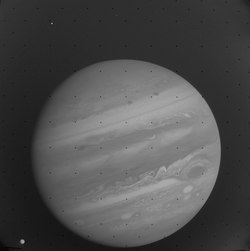Portal:Jupiter/Radiation astronomy/16
Violets
[edit | edit source]


"This movie [at right] records an eruptive event in the southern hemisphere of Jupiter over a period of 8 Jupiter days. Prior to the event, an undistinguished oval cloud mass cruised through the turbulent atmosphere. The eruption occurs over a very short time at the very center of the cloud. The white eruptive material is swirled about by the internal wind patterns of the cloud. As a result of the eruption, the cloud then becomes a type of feature seen elsewhere on Jupiter known as "spaghetti bowls.""[1]
"As Voyager 2 approached Jupiter in 1979, it took images of the planet at regular intervals. This sequence is made from 8 images taken once every Jupiter rotation period (about 10 hours). These images were acquired in the Violet filter around May 6, 1979. The spacecraft was about 50 million kilometers from Jupiter at that time."[1]
At left is a "Voyager 1 image showing Jupiter with its satellite Io visible at lower left. Jupiter is 140,000 km in diameter and Io is 3600 km across. This image was taken with the narrow angle camera using the violet filter from a distance of 25 million km on 9 February 1979. North is at about 11:00 (Voyager 1, 15672.37)".[2]
"These images [at lower right] show the apparent edge (limb) of the planet Jupiter as seen through both the violet filter (top frame) and an infrared filter (756 nanometers, bottom frame) of the Solid State Imaging (CCD) system aboard NASA's Galileo spacecraft. North is to the top of the picture. A separate haze layer is clearly visible above the northern part of the limb."[3]
"This haze layer becomes less well defined to the south (bottom left). Such a detached haze layer has been seen previously on only one other body with a thick atmosphere: Saturn's satellite Titan. The haze layer cannot be lower in the atmosphere than a pressure of about 10 millibars (mbar), or about 40 kilometers (km) above the tropopause. (The tropopause, where the temperature stops decreasing with height, is at about 100 mbar, 20 km above the tops of the ammonia clouds.) There is some indication of streaks of slightly brighter and darker material running roughly north-south (parallel to the limb) on Jupiter's crescent."[3]
"The images, which show the limb between 60.5 degrees and 61.8 degrees North latitude (planetographic) and near 315 degrees West longitude, were obtained on December 20, 1996 Universal Time. The spacecraft was about 1,286,000 km (18.0 Jovian radii) from the limb of Jupiter and the resolution is about 13 kilometers per picture element."[3]
References
[edit | edit source]- ↑ 1.0 1.1 Image Processing Laboratory (6 April 2000). PIA02257: Voyager 2 Jupiter Eruption Movie. Pasadena, California USA: NASA/JPL. http://photojournal.jpl.nasa.gov/catalog/PIA02257. Retrieved 22 March 2013.
- ↑ Voyager 1 team (9 February 1979). Jupiter, Io - Voyager 1. Greenbelt, Maryland USA: NASA Goddard Space Flight Center. http://nssdc.gsfc.nasa.gov/imgcat/html/object_page/vg1_1567237.html. Retrieved 22 March 2013.
- ↑ 3.0 3.1 3.2 Sue Lavoie (6 March 1998). PIA01195: Hazes near Jupiter's Limb (60 degrees North, 315 degrees West). Pasadena, California USA: NASA/JPL. http://photojournal.jpl.nasa.gov/catalog/pia01195. Retrieved 1 April 2013.
